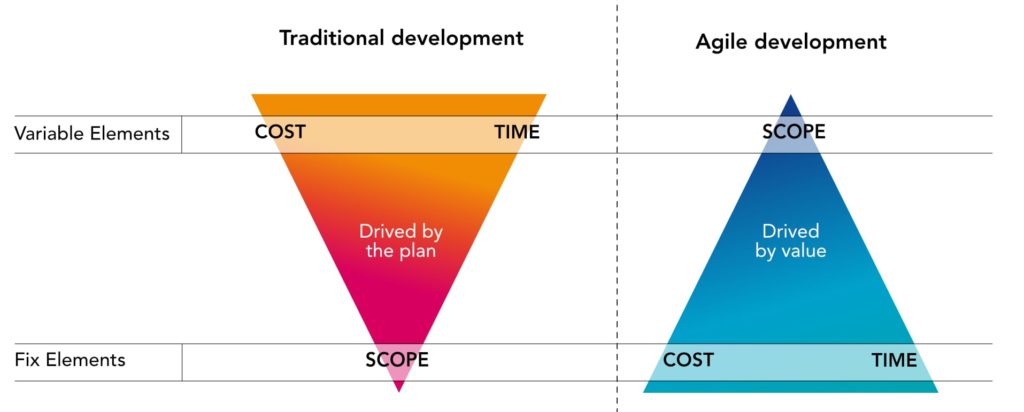What is Agile methodology? What are its principles? What are the benefits of Enterprise Agile Transformation, turning your company in an Agile Enterprise?
The result of a search for continuous improvement in the software development process, the Agile methodology appeared at the forefront of ICT in the late 1990s in response to the excesses of major software development projects in terms of schedule, budget and quality of deliverables.
And this quest for continuous improvement in software development is in fact based on the search for added value for the company (project scope) and the optimization of the performance of software development teams within fixed schedule and costs as illustrated in the diagram below:

The spirit of the Agile Manifesto and Enterprise Agility
Although there are different Agile approaches including the Agile SCRUM approach, advocates of the Agile methodology will agree and explain that the four values set out in the Agile Manifesto encourage a quality-driven software development process by creating products that meet consumers’ needs and expectations.
– value individuals and interactions rather than processes and tools
– value functional software rather than comprehensive documentation
– value customer collaboration rather than contract negotiation
– respond to change rather than following a plan
And the 12 principles that flow from it, as set out in the Agile Manifesto, are designed to create and support continuous integration and a customer-focused work environment that meets the company’s objectives and can respond and turn around quickly as user needs and market forces evolve.
The 12 principles set out in the Agile Manifesto:
- Our highest priority is to satisfy the customer through early and continuous delivery of valuable software.
- Welcome changing requirements, even late in development. Agile processes harness change for the customer’s competitive advantage.
- Deliver working software frequently, from a couple of weeks to a couple of months, with a preference to the shorter timescale.
- Business people and developers must work together daily throughout the project.
- Build projects around motivated individuals. Give them the environment and support they need, and trust them to get the job done.
- The most efficient and effective method of conveying information to and within a development team is face-to-face conversation.
- Working software is the primary measure of progress.
- Agile processes promote sustainable development. The sponsors, developers, and users should be able to maintain a constant pace indefinitely.
- Continuous attention to technical excellence and good design enhances agility.
- Simplicity–the art of maximizing the amount of work not done–is essential.
- The best architectures, requirements, and designs emerge from self-organizing teams.
- At regular intervals, the team reflects on how to become more effective, then tunes and adjusts its behavior accordingly.
Also, as success attract success, it became natural that other company managers wanted to adapt to their processes the very same principles of Agile Methodology that have contributed so much to the success of software development teams.
Why proceed with your Enterprise Agile Transformation?
In an ideal world, we would like the continuous improvement process specific to the Agile method to be integrated at all levels of the company, especially in terms of product development, in order to respond more quickly to market changes.
Similarly, we would like the innovation inherent in the Agile method to be strongly encouraged in order to meet customer needs in a more personalized way.
From an entrepreneurial perspective, Jean-Loup Richet (Senior Lecturer at the IAE de Paris – Sorbonne Business School) highlights the importance of organizational Agility in innovative and uncertain contexts (start-ups, free electron business units, or even subsidiaries in a state of flux): “The advantage of this approach is that it allows an innovative product to be brought to market faster and more efficiently: customer need orientation, cost and time optimization, no waste, and finally better financial performance compared to a traditional product development method. »
Moreover, more than 90% of executives consider “Agility and collaboration” to be essential to the success of their business. This in turn reflects McKinsey & Company’s conclusions that companies and units implementing the Agile methodology have better financial profitability than those that do not.
The benefits of transforming into an Agile Enterprise
In a recent article and following numerous studies and analyses with companies in the process of Agile transformation, Deloitte summarized the benefits of the Agile Enterprise as follows:
Attributes of the Agile Enterprise
– a homogeneous corporate culture within the entire organization
– end-to-end responsibility of stakeholders in product development
– multifunctional and cross-functional work teams
– adoption of Agile principles by all business units and functions
Advantages of the Agile Enterprise
– superior increase in customer and employee satisfaction
– organizational flexibility to respond quickly to any changes
– very fast time to market
Conclusion
In the end, considering all its advantages and benefits, integrating the principles of the Agile methodology involves very little risk for your company other than for those managers who are unable to trust and delegate and, adapt to change.
The latter will most likely also feel in direct competition with some newcomer equivalents specific to the Agile methodology such as SCRUM Masters and Product Owners…




Leave a Reply